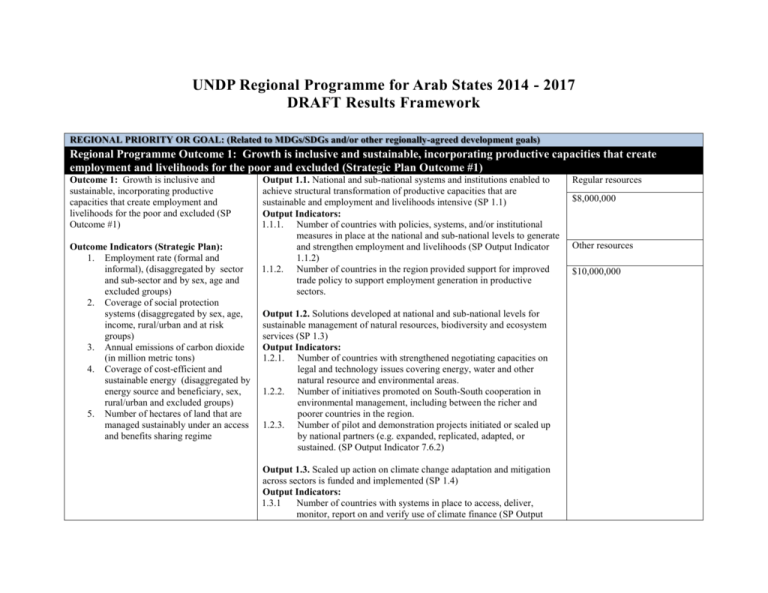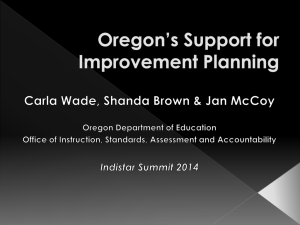RBAS Regional Programme 2014-2017- IRRF-22 Nov 2013
advertisement

UNDP Regional Programme for Arab States 2014 - 2017 DRAFT Results Framework REGIONAL PRIORITY OR GOAL: (Related to MDGs/SDGs and/or other regionally-agreed development goals) Regional Programme Outcome 1: Growth is inclusive and sustainable, incorporating productive capacities that create employment and livelihoods for the poor and excluded (Strategic Plan Outcome #1) Outcome 1: Growth is inclusive and sustainable, incorporating productive capacities that create employment and livelihoods for the poor and excluded (SP Outcome #1) Outcome Indicators (Strategic Plan): 1. Employment rate (formal and informal), (disaggregated by sector and sub-sector and by sex, age and excluded groups) 2. Coverage of social protection systems (disaggregated by sex, age, income, rural/urban and at risk groups) 3. Annual emissions of carbon dioxide (in million metric tons) 4. Coverage of cost-efficient and sustainable energy (disaggregated by energy source and beneficiary, sex, rural/urban and excluded groups) 5. Number of hectares of land that are managed sustainably under an access and benefits sharing regime Output 1.1. National and sub-national systems and institutions enabled to achieve structural transformation of productive capacities that are sustainable and employment and livelihoods intensive (SP 1.1) Output Indicators: 1.1.1. Number of countries with policies, systems, and/or institutional measures in place at the national and sub-national levels to generate and strengthen employment and livelihoods (SP Output Indicator 1.1.2) 1.1.2. Number of countries in the region provided support for improved trade policy to support employment generation in productive sectors. Output 1.2. Solutions developed at national and sub-national levels for sustainable management of natural resources, biodiversity and ecosystem services (SP 1.3) Output Indicators: 1.2.1. Number of countries with strengthened negotiating capacities on legal and technology issues covering energy, water and other natural resource and environmental areas. 1.2.2. Number of initiatives promoted on South-South cooperation in environmental management, including between the richer and poorer countries in the region. 1.2.3. Number of pilot and demonstration projects initiated or scaled up by national partners (e.g. expanded, replicated, adapted, or sustained. (SP Output Indicator 7.6.2) Output 1.3. Scaled up action on climate change adaptation and mitigation across sectors is funded and implemented (SP 1.4) Output Indicators: 1.3.1 Number of countries with systems in place to access, deliver, monitor, report on and verify use of climate finance (SP Output Regular resources $8,000,000 Other resources $10,000,000 1.3.2 Indicator 1.4.1). Number of countries with comprehensive measures - plans, strategies, policies, programmes and budgets - implemented to achieve low-emission and climate resilient objectives. (SP Output Indicator 1.4.2). Output 1.4. Legal and regulatory frameworks, policies and institutions enabled to ensure the conservation, sustainable use, and access and benefit sharing of natural resources, biodiversity and ecosystems, in line with international conventions and national legislation (SP Output 2.5) Output Indicators: 1.4.1. Number of countries implementing national and local plans for Integrated Water Resources Management. (SP Output 2.5.2) Output 1.5 Global (regional) consensus on completion of MDGs and the post 2015 agenda informed by contributions from UNDP (SP Output 7.1) Output Indicators: 1.5.1. Proportion of organizations by type participating in dialogues on the post 2015 agenda and sustainable development goals (disaggregated by type of organization – e.g. government, civil society and women’s organizations etc.) (SP 7.1.1) Regional Programme Outcome 2: Citizen expectations for voice, effective development, the rule of law and accountability are met by stronger systems of democratic governance (Strategic Plan Outcome #2) Regional programme outcome: baseline, indicator(s), targets, and sources of data Indicative regional programme outputs Indicative resources by regional programme outcome Outcome 2: Citizen expectations for voice, effective development, the rule of law and accountability are met by stronger systems of democratic governance (SP Outcome #2) Output 2.1. Parliaments, constitution making bodies and electoral institutions enabled to perform core functions for improved accountability, participation and representation, including for peaceful transitions (SP 2.1) Output Indicators: 2.1.1. Number of Parliaments, constitution making bodies and electoral institutions which meet minimum benchmarks (to be defined) to perform core functions effectively (SP 2.1.1) 2.1.2. Proportion of women (to men) participating as candidates in local and national elections. (SP Output Indicator 2.1.3) 2.1.3. Number of sub-national governments/administrations which have functioning planning, budgeting and monitoring systems. (SP Output Indicator 3.2.2). Regular resources Outcome Indicators (Strategic Plan): 1. Number of countries with open access to data on budgets, expenditures and public procurement 2. Voter turnout (disaggregated by sex, age, and excluded groups) 3. Proportion of women to men in Parliaments $7,550,000 Other resources 12,000,000 4. Peaceful completion of electoral and constitutional processes Output 2.2. Institutions and systems enabled to address awareness, prevention and enforcement of anti-corruption measures across sectors and stakeholders (SP 2.2) Output Indicators: 2.2.1. Number of proposals adopted to mitigate sector specific corruption risks (e.g. extractive industries, public procurement in the health and other sectors) (SP 2.2.2) 2.2.2. Number of countries actively participating in the Arab AntiCorruption and Integrity Network (ACINET) Output 2.3. Frameworks and dialogue processes engaged for effective and transparent engagement of civil society in national development (SP Output 2.4) Output Indicators: 2.3.1. Quality (to be defined) of civil society engagement in critical development and crisis related issues, disaggregated by women’s and youth groups, indigenous peoples and other excluded groups. (SP Output 2.4.1). 2.3.2. Number of civil society organizations/networks with mechanisms for ensuring transparency, representation and accountability. (SP Output 2.4.2). Output 2.4 Mechanisms in place to generate and share knowledge about development solutions (SP Output 7.7) Output Indicators: 2.4.1. Evidence of (e.g. number of citations, downloads and site visits) Arab Human Development Reports and knowledge products contributing to development debate and action. (SP Output Indicator 7.7.1). 2.4.2. Evidence of (e.g. user survey) the relevance of development solutions to national partners that are shared over the knowledge platform. (SP Output Indicator 7.7.3) 2.4.3. UNDP offices and the country partners in the region are able to collect data through the national statistical systems under the new Strategic Plan in view of monitoring and reporting vis-à-vis the national development processes 2.4.4. Number of South-South and triangular cooperation arrangements established that deliver measurable development benefits for participants (country, regional, sub-regional, inter-regional). (SP Output Indicator 7.5.1). Regional Programme Outcome 3: Faster progress is achieved in reducing gender inequality and promoting women’s empowerment (Strategic Plan Outcome #4) Outcome 3: Faster progress is achieved in reducing gender inequality and promoting women’s empowerment (SP Outcome #4) Outcome Indicators (Strategic Plan): 1. Wage gaps between men and women, (disaggregated by rural and urban) 2. Women’s access to credit (commercial and micro-credit) 3. Proportion of women subjected to physical or sexual abuse in the last 12 months 4. Proportion of decision making positions (executive, legislative and judicial) occupied by women at national and sub-national levels 5. Proportion of decision making positions in peace building processes which are occupied by women Output 3.1. Country led measures accelerated to advance women’s economic empowerment (SP Output 4.1) Output Indicators: 3.1.1. Number of countries with policies being implemented to promote women’s economic empowerment. (SP Output Indicator 4.1.1). Output 3.2 Measures in place and implemented across sectors to prevent and respond to Sexual and Gender Based Violence (SGBV) (SP Output 4.2) Output Indicators: 3.2.1. Number of countries that have a legal and/or policy framework in place to prevent and address sexual and gender based violence (SP Output Indicator 4.2.1) Regular Resources $1,000,000 Other Resources $4,000,000 Output 3.3. Evidence-informed national strategies and partnerships to advance gender equality and women’s empowerment (SP Output 4.3) Output Indicators: 3.3.1. Number of countries undertaking research and advocacy to advance gender equality and women’s empowerment. (SP Output Indicator 4.3.1). Output 3.4. Measures are in place to increase women’s participation in decision-making (SP Output 4.4) Output Indicators: 3.4.1. Number of laws and policies in place to secure women’s participation in decision making. (SP Output Indicator 4.4.1). Regional Programme Outcome 4: Early recovery and rapid return to sustainable development pathways are achieved in postconflict and post-disaster settings (Strategic Plan Outcome #6) Outcome 4: Early recovery and rapid return to sustainable development pathways are achieved in post-conflict and post-disaster settings (SP Outcome #6) Outcome Indicators (Strategic Plan): 1. Extent to which the agreed post 2015 Output 4.1 Recovery processes reinforce social cohesion and trust and enable rapid return to sustainable development (SP Output 6.4) Output Indicators: 4.1.1. Percentage of people in target areas with improved perceptions of social cohesion within twelve to eighteen months after conflict ends, disaggregated by sex and age. (SP Output Indicator 6.4.2). Regular Resources $3,655,000 2. 3. 4. 5. agenda and sustainable development goals reflects sustainable human development concepts and ideas Existence of an initial global agreement on financing mechanisms for the post 2015 agenda and sustainable development goals Number of countries integrating and adapting the post 2015 agenda and sustainable development goals into national development plans and budgets Existence of a global succession plan to ensure unfinished MDGs are taken up post 2015 Number of countries with post-2015 poverty eradication commitments and targets Output 4.2. Effective institutional, legislative and policy frameworks in place to enhance the implementation of disaster and climate risk management measures at national and sub-national levels (SP Output 5.2) Output Indicators: 4.2.1. Number of national/sub-national development and key sectoral plans explicitly addresses disaster and climate risks management. (SP output indicator 5.2.2) Output 4.3 Mechanisms are enabled for consensus-building around contested priorities, and address specific tensions, through inclusive and peaceful processes (SP Output 5.6) Output Indicators: 4.3.1. Numbers of countries in which tensions or potentially violent conflicts are peacefully resolved by national mechanisms for mediation and consensus building. (SP Output Indicator 5.6.1) 4.3.2. Number of mechanisms for mediation and consensus building capable to perform core functions. (SP Output Indicator 5.6.2) 4.3.3. Number of conflict risk assessments that are informing development planning and programming in key development sectors (SP Output Indicator 5.1.3) Other Resources $3,000,000





